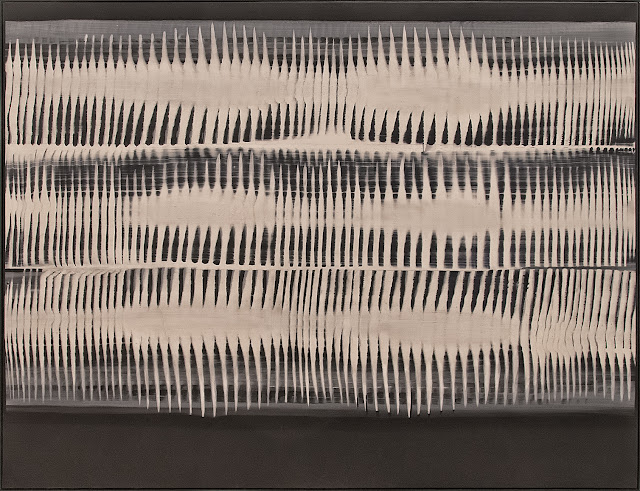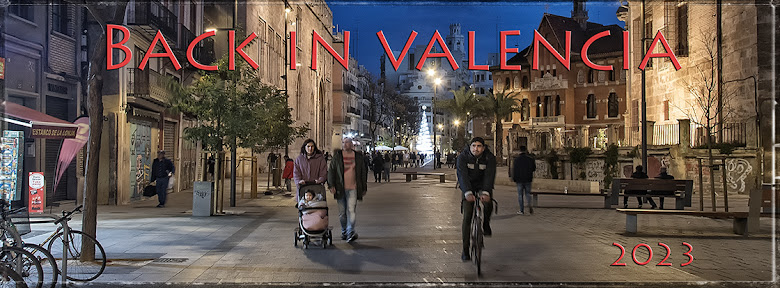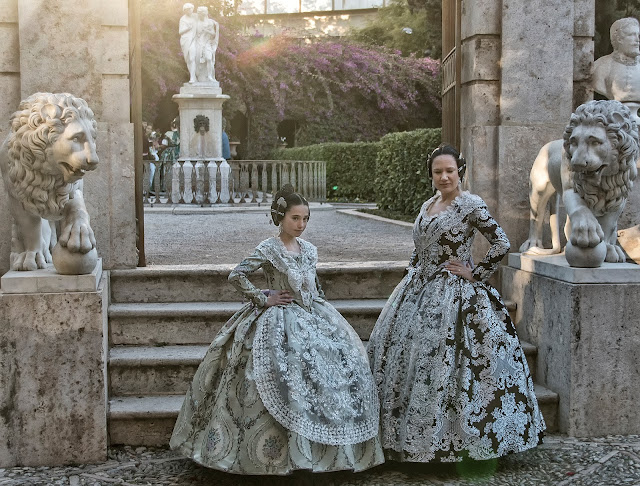Monday, January 30, 2023 - As planned, late in the afternoon on Saturday - a little too late for good photography, as it turned out - we set off for Jardi de Montforte. Our idea was to cycle there and walk back. We went to the Valenbisi station on Gran Via, but once again, it had lost Internet connectivity, shutting it down, at least for users like Karen with Mobilis cards. We will in future avoid it. We walked down Gran Via to Turia, picked up bikes there and rode the rest of the way.
Jardi de Montforte is a neo-classical style formal garden, designed and built in the mid-19th century by the architect Sebastián Monleón Estellés. It was commissioned by Don Juan Bautista Romero Almenar, Marqués de San Juan who had recently purchased the land, an old orchard just outside the city’s walls, from another nobleman. The gardens later came into the hands of a relative by marriage named Montforte - hence the modern name.
It has been city property and open to the public since the 1970s. It’s managed, we noticed, by the municipal department responsible for marriage licenses and records. I wonder if that’s because it’s a popular venue for weddings, wedding photography and receptions, which it appears to be.
On this day, there was no wedding activity but there were three different photo shoots underway. When we went in the main entrance, Karen exclaimed, “Oh, look at the pretties!” There in the entryway courtyard were a mother and, I’m assuming, her two children posing in full Fallas finery. The women and girls wear vaguely 18th century dresses, made of beautifully embroidered fabrics held out by crinolines, and often lace aprons. They have their hair done in elaborate coiffures with combs and pinned-up coils on the sides of their heads that remind me of pictures we saw of Mayan women in Mexico. The dresses cost a fortune - according to the Hereditas website between €2,000 and €12,000!
The men also wear 18th-century-inspired garb: knee britches, hose and puffy shirts, usually with a brightly-striped blanket over one shoulder. They play a distant second fiddle to the women, though. As we arrived, the photo shoot in the courtyard was just finishing up. The photographer asked the young boy to step aside while he took some shots of his mother and sister. I had no time to adjust camera settings but grabbed a quick shot at the same time. And then they were gone.
There was another party shooting Fallas finery in another part of the garden - but they also broke up just before I could horn in. And a third group was photographing a model in what looked like a party dress.
It’s a peaceful place with lots of neo-classical statuary, fountains, pools, neatly trimmed shrubberies and quiet corners with benches. There were a few people besides the photogs and models enjoying the place - a couple snogging in the back corner, a fellow sitting on a bench reading - but it was a bit cool for Valencians to think of hanging around in a garden, and the sun was pretty much gone behind the buildings by the time we got there. I’m sure it’s a very popular place in the summer when it’s blisteringly hot here.
There are also, despite the time of year, some quite spectacular floral displays, including climbing vines and clumps of birds of paradise. Shots of the latter I managed to translate into one of the only multiple exposures I’ve tried here that sort of works.
We picked up bikes nearby and rode part way home, then walked the rest of the way.
Sunday is IVAM day in Valencia for us. We missed last Sunday - can’t remember why - but went yesterday. It was the coolest day yet, I think - only got up to 9C. We walked through the centre and Carmen to get there, with the idea we could cycle back. I’d prepped our mid-afternoon main meal ahead of time so all I had to do was bake the store-bought tortilla a little and boil some veg when we got home. We set out a little before 2.
I had thought we would take in an exhibit by Asger Jorn (1914–1973), a Danish expressionist painter, which is advertised with a giant banner on the wall outside the museum. What I failed to notice was that the exhibit doesn’t start until February, just before we leave. So we went into another, Zero and Postwar Art in Europe.
 |
| Heinz Mack, White Dynamic Structure on Black, 1962 |
 |
| Gerhard von Ravenitz, Kinetic Relief, 1965 |
This one is about the largely forgotten European artists who reacted against the expressionist art that had dominated the scene before the war. They advocated a kind of minimalism and anonymity, often forming collectives, even foregoing individual attribution of their works in some cases. It started in Germany - the Zero group - and eventually spread to allied groups in France, Italy and Spain.
 |
| Osker Holweck, 9.VIII.58, 1958 |
 |
| Walter Leblanc, Twisted String 40F X 180, 1962 |
 |
| Gruppo No - esecuzione Bissi e Landi, Untitled, 1964 |
 |
| Jean Tinguely, Méta-matic no. 6, 1959 |
Karen and I were a little dubious when we read the opening description of the exhibit, but surprised ourselves by quite liking some of it. This, it occurs to me, was the avant garde art of our youth. Some of it was minimalist to the point of silliness, but some was quite engaging. The frequent absence of colour precludes it ever being among my favourite art styles, but it’s interesting at the very least.
We picked up bikes right outside the museum and cycled home along Guillem de Castro and Xativa. Karen for the first time took the lead, which is a much better way for us to do it. It means I don’t have to keep looking over my shoulder to check she’s still with me, and she can set a pace that doesn’t over-extend her wonky knees.
























































